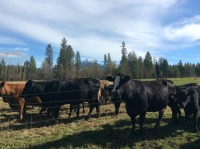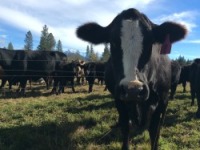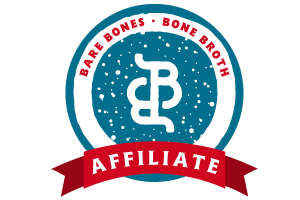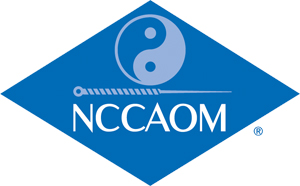I always recommend pasture raised animal products to my patients. When I suggest pasture-raised, I am doing so for multiple reasons. One significant factor I want my patients to understand is that pasture-raised products have a different nutritional profile than grain-finished meat products. The National Institutes of Health, a government agency, which funds health and medical research, has published studies verifying the superiority of grass-fed meat products in terms of nutritional value. Grass finished meats have 2-5 times more omega-3 fatty acids than grain finished meats. They contain beta-carotene, conjugated linoleic acids, and also contain significantly more of the antioxidants vitamin E, glutathione, superoxide dismutase (SOD), and catalase than grain-fed beef. These antioxidants play an important role in protecting our cells from oxidation, especially delicate fats in the cell membrane such as omega-3 and omega-6. You can wade through the analysis here.
This reason alone is enough to help most people switch to grass-finished products whenever possible, but sometimes we need to consider an even larger picture than our personal health. Consider this or that:
This: Grain-Finished
Whether we know it or not, when we choose grain finished animal products we are supporting practices unhealthy for the animals we consume, the land on which they are raised, the watersheds surrounding their feedlots and the planet at large. As Michael Pollen, noted author of Omnivore’s Dilemna, said:
“The feedlot’s ecosystem, I could see, revolves around corn. But its food chain doesn’t end there, because the corn itself grows somewhere else, where it is implicated in a whole other set of ecological relationships. Growing the vast quantities of corn used to feed livestock in this country takes vast quantities of chemical fertilizer, which in turn takes vast quantities of oil—1.2 gallons for every bushel. So the modern feedlot is really a city floating on a sea of oil.”
When we choose grain-finished products, which account for 97% of the meat products sold in the US, we are supporting the extraction of fossil fuels and their attendant greenhouse effects.
When we choose grain-finished we are supporting the GMO corn industry. You can see my posts about GMO here, here, here and here to consider where you stand on genetically modified organisms in our diets.
British photographer Mishka Henner’s arial photo series of confinement animal feedlot operations (CAFO) in Texas are stunning. Without words, they show us the terrible toll feedlots take on the land. The manure ponds produce unhealthy algae blooms on the pond surface. These vast ponds contain manure at toxic concentrations that can seep into the groundwater, run-off into the local watershed causing higher concentrations of pollutants. Biting into that burger, your mind isn’t picturing this terrible view.

 Feedlot cows, the land around them and water downstream are sick and flavorless. Left photo by Mishka, Henner, Right photo from Hawaiian Libertarian.
Feedlot cows, the land around them and water downstream are sick and flavorless. Left photo by Mishka, Henner, Right photo from Hawaiian Libertarian.
American meat products are loaded with antibiotics, which contribute to antibiotic resistance and may alter our guts’ micro flora. Many producers use large amounts of antibiotics in their meat production because animals are not meant to consume large quantities of grain. Their bodies are adapted to digest grasses. They have specialized digestive systems with multiple stomachs where grasses are fermented by their unique gut flora and broken down by enzymes that target the structure of grasses. When these animals are fed a grain-based diet, they get sick. The problem is made worse because such large numbers of animals are kept in such small spaces and live their lives surrounded by their shared manure. You can imagine just how easy it is for the cattele to get ill.
That: Grass-Finished or Pasture-Raised
Grass-fed cows and the land and watershed are happy, healthy and tasty.
When you choose to eat grass-finished products, you are supporting healthy animals. These animals are living in grass-covered pastures, in numbers sustainable by the vegitation in pasture. The herds do not require antibiotics because there are not large populations of cattle living in a small confined space.
When you choose grass-finished, products, you choose healthy land and water usage. We support keeping natural waste products in low enough concentrations that nature can effectively utilize or detoxify them.
When you choose grass-finished, you are choosing to support food as nature makes it, not as it is in engineered in the lab. Sustaainable meats are not produced with GMO feed.
When you choose grass-finished, you choose to support practices that do not contribute to global warming on a massive scale. We choose to allow nature’s carbon cycle to work as it was intended.

 Grass-fed cows are happy cowsThis article appeared in the November 2014 Savor Your Health Newsletter. Sign up in the Sidebar to get more tips, tricks and delicious recipes delivered to your inbox every month.
Grass-fed cows are happy cowsThis article appeared in the November 2014 Savor Your Health Newsletter. Sign up in the Sidebar to get more tips, tricks and delicious recipes delivered to your inbox every month.
 Monday, December 1, 2014 at 2:11PM
Monday, December 1, 2014 at 2:11PM 

 turkey in
turkey in  This or That
This or That 













